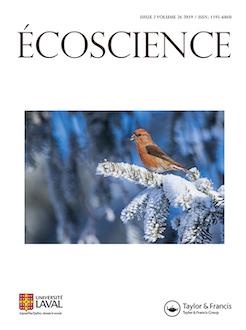In the boreal forest of eastern North America, the distribution of eastern white cedar (Thuja occidentalis) is characterized by a latitudinal fragmentation gradient from south to north. Marginal populations could be outposts allowing cedar to expand its presence in the north in response to climate change. This study aimed to characterize the spatio-temporal regeneration dynamics of 20 marginal cedar stands in order to evaluate their expansion capacity into adjacent black spruce stands. Cedar recruitment within marginal cedar stands was mainly by layering, which allowed the species to maintain for a long time in the landscape. However, the rate of expansion of marginal stands into adjacent black spruce stands through seed dispersal was very low (0.28 m.year–1) and it was negatively influenced by distance to seed trees. Substrate had no significant effect. Global warming could lead to increased seed production by cedar, which could favour the species' expansion at its northern distribution limit. However, global warming could also increase the frequency and severity of wildfires, which would have a negative effect on cedar expansion capacity.
How to translate text using browser tools
8 March 2019
Limited Recruitment of Eastern White Cedar (Thuja occidentalis L.) under Black Spruce Canopy at its Northern Distribution Limit
Isabelle Visnadi,
Johann Housset,
Cécile Leroy,
Christopher Carcaillet,
Hugo Asselin,
Yves Bergeron
ACCESS THE FULL ARTICLE

Ecoscience
Vol. 26 • No. 2
March 2019
Vol. 26 • No. 2
March 2019
biogeography
climate change
dendrochronology
Layering
range expansion
regeneration





